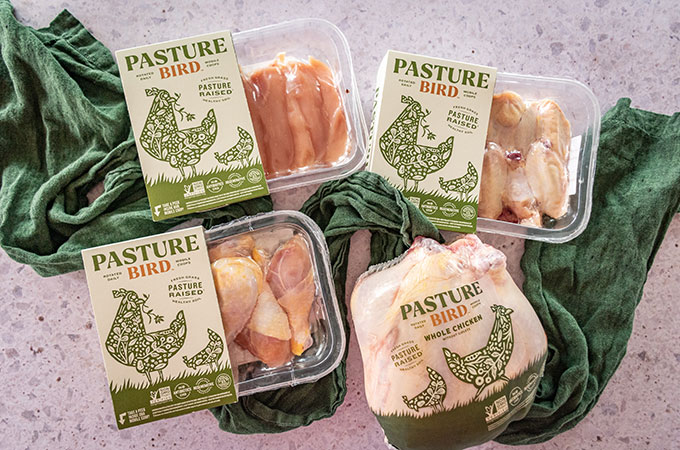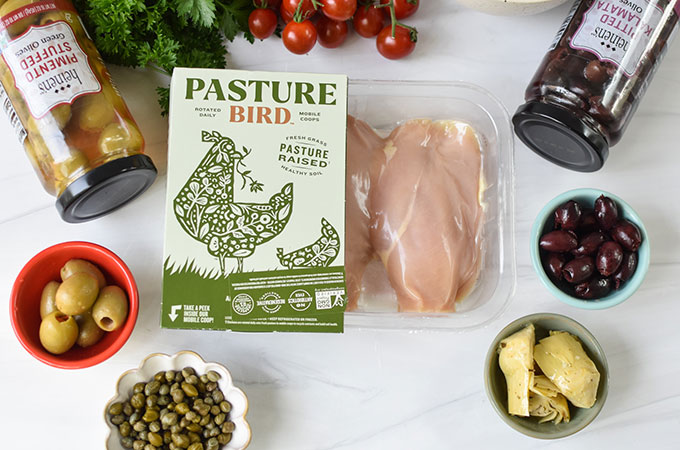We Know Our Sources: Pasturebird Chicken

The following story was written by Heinen’s partner Elaine T. Cicora.
Marine Corps veteran, business founder, and farmer, Paul Greive takes his duty to his chickens seriously – and it has paid off. Utilizing a unique combination of age-old farming wisdom and smart new technologies, Greive has found a way to heal the soil, encourage biodiversity, and leave the land in better shape than he found it.
In the process, he’s raising some mighty fine chickens, too. The name of Greive’s enterprise – Pasturebird – says it all. And since 2022, Pasturebird has been one of Heinen’s trusted partners, providing delicious, 100% pasture-raised chicken to our customers.
The Difference of Pasture-Raised
While factory-raised chickens have become the norm, raising chickens on pasture, with 24/7 access to grass, bugs, water, and fresh air, is an approach as old as farming. Not only does it result in healthy birds, but it yields impressive nutritional benefits. According to studies, pasture-raised poultry offers three times the Omega-3 levels as factory-farmed birds. “It’s also 50% higher in Vitamin A and E, contains four to 12 times the level of micronutrients like Vitamin B-12, and contains 21% less saturated fat because the chickens are outside and running around all day,” Greive adds.
In addition, Pasturebird birds are GMO free, and are raised without hormones or antibiotics. “The chickens are naturally healthy,” Greive says, “so they don’t need drugs.”
The Evolution of Pasturebird Chicken
Grieve’s own interest in healthful foods began when he returned home to Southern California after serving in Iraq. “My family and I were hoping to improve our diets, but we couldn’t find pasture-raised chickens,” he says. “So, sort of as a joke, we decided to try raising our own.” He began with a flock of 50, and quickly learned an important lesson: Raising chickens is expensive. When he decided to try to sell a few of the processed birds on Facebook to offset the costs, his entire flock was spoken for within two weeks. (“My family was pretty upset with me,” Grieve recalls, “because they didn’t get any chicken.”)
Clearly, there was a big demand for chickens raised on pasture. And by 2013, business was starting to boom. Soon, Greive and his family were selling their pasture-raised birds to top LA restaurants, as well as to professional sports teams like the LA Lakers and the LA Dodgers.
The next step in the business’s evolution came in 2015. “We were small and independent,” Grieve’s says, “and raising chickens was hard and expensive. But we came to this odd realization, that we didn’t just want to sell food for rich people. So we started thinking about what it would take to get to a better price point.”
The conclusion was to scale up and move the operations to Butler, Georgia, where land was less expensive and rainfall more abundant. Since that time, Grieve and his team have devoted themselves to raising healthy, nutrient-dense chickens that are affordable and accessible to all.
In the process, the focus has been squarely on regenerative farming, says Grieve. The goal is ensuring that every single one of Pasturebird’s 750 acres gets better – healthier, more nutrient rich, and biodiverse – every single year.
The Invention of the Automated Range Coop (ARC)
To that end, the team invented a game changer: the Automated Range Coop, a floorless coop on wheels, powered entirely by solar energy. According to Greive, the 7,500-square-foot coops move 50 feet per day, over the course of 5 to 7 minutes, “so the chickens can keep up.” The daily relocation not only yields fresh grass and bugs for the birds, but also helps spread a beneficial layer of chicken manure across the land, while keeping the chickens out of their own waste. Each ARC returns to its starting point in 90 days. While the coops provide shelter, shade, and water, they also allow the chickens complete exterior access.
“Fresh pasture, every day, is the ultimate enrichment for chickens,” Greive says. “It puts them in an environment where they can just be chickens and do what chickens do.
“You can’t actually see them smile,” he admits. “But I think they are.”
Behind the Scenes of Regenerative Farming
Besides the happy chickens, the regenerative cycle also involves cattle. “We aren’t raising a monocrop,” Greive notes. “The large animals come through first and graze on the tall grass, then the birds follow. That way, the chickens have easier access to the bugs left behind.”
The positive impact on the land has been enormous, Greive says. “We’ve been using land that has had years of abuse from commercial plant agriculture, and we go in with our ‘poop machines’ and the soil just wakes up. You start seeing the bugs come back, the grasses flourish, and the wildlife thrives.” Plus, regenerative techniques sequester carbon in the soil and improve water retention. “Now, the land is filled with ladybugs, butterflies, coyotes – we even have a bobcat! Nature has really made a comeback.”
All About Transparency
Greive knows his success is worth sharing with his customers. “We believe transparency is the best marketing tool we have,” he explains, adding that Pasturebird has hosted more than 30,000 visitors to their farm in recent years. You can sign up for the next farm tour on their website or follow Pasturebird on Facebook to watch live-streamed footage from inside the actual coops.
“We have nothing to hide,” Greive emphasizes. “We are different from anything else in the grocery store, but we are part of a movement for true pasture-raised poultry. We offer the convenience, the price point, and the health benefits – and we want our customers to see exactly how we raise our birds, day in and day out.”

What’s Next for Pasturebird?
With demand continuing to grow, Greive says Pasturebird needs more land. To meet that need, the grower is starting to partner with other farmers to become part of their crop-rotation system. “We can regenerate their land with our chickens, and then the farmers can come back and plant their corn or soy and have better, more fertile soil. It’s an idea as old as our grandfathers; we didn’t invent it. But it benefits us all.”
Pasturebird has also recently entered into a partnership with the Perdue Chicken family. “It may seem a little strange,” Greive acknowledges, “but Perdue, like us, is family-owned, and has been in business for 100 years. They’ve led the way on animal welfare, and we really feel that big companies helping small companies grow is an important part of our future.”
Heinen’s and Pasturebird: A Natural Partnership
That understanding of partnership as a path to growth also informs Pasturebird’s relationship with Heinen’s. “We were born as a small company with family values that extend beyond making a profit – and Heinen’s has epitomized that approach for a long time,” says Greive. “They are our first-ever account in the Midwest, and to see Heinen’s customers embrace our products has been very cool.

“We take it seriously when people decide to vote with their dollars,” Greive adds. “And we have sincere gratitude for the Heinen’s customers whose support has made our work possible.”


